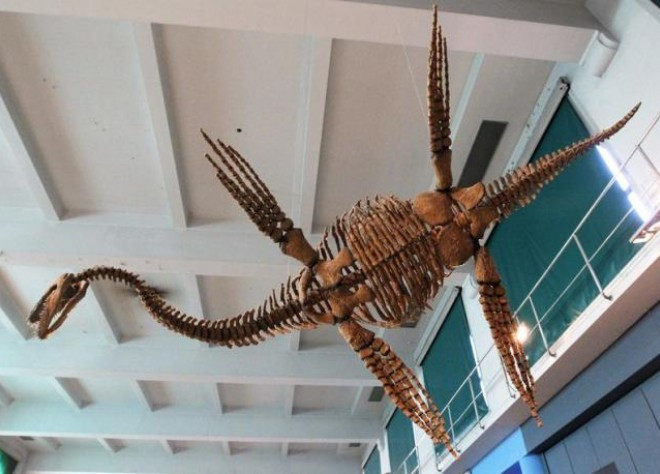The ancient 'Loch Ness' monster swims like a penguin
The mystery of the swimming style of the dragon (Plesiosaur), an ancient creature with a unique body, was decoded by scientists after nearly two centuries of controversy.
Reuters said, the dragon, the ancient reptile fluttering in the ocean in the period of dinosaurs dominate the ground, has a type of penguin swimming.
Quy Long has a special body structure with wide body, almost like turtle body, four big flippers and an unusually long neck. They lived in the ocean from 200 million years to 66 million years ago and disappeared into the era of great genocide that eradicated the dinosaurs from Earth.
In the study published on the PLOS Computational Biology on December 17, scientists said they were moving the flippers similarly to the "flying wing" movement under water.
Seeking solutions for the nearly 200-year-long debate, the researchers conducted a series of simulation experiments based on the 180 million-year-old Meyerasaurus long- bones species and found the most effective way to swim against the nest. Their unique body function. Accordingly, the method for the fastest swimming speed is to beat two synchronized up and down flippers, like the penguin and sea turtle swimming style.

Copy of Plesiosau r named "Tuarangisaurus Cabazai" made of polyurethane resin powder was recorded at the Argentine Natural Science Museum, in the capital Buenos Aires on July 1, 2013.(Photo: Reuters).
"The surprise is that in all the simulations for the following two flippers, they basically do not contribute to the body push forward," said Greg Turk, professor of computer science at Georgia Institute of Technology, USA. said.
Instead, the limb can act as a guide and maintain the strength of the dragon's underwater movement, the researchers said.
The dragon resembles the description of Nessie, the Loch Ness mysterious lake monster, and was dubbed the ancient Loch Ness monster . They eat fish and squid to survive and vary in shape and size.
Some long-legged species have short necks, while others have long necks like Elasmosaurus, which are 14m long.
Meyerasaurus, a skeletal dragonfly species used in simulation experiments, was excavated in Germany, with a length of 3m.
According to Professor Turk, dragon fruit is a collection of great ancient predators that are highly effective. However, in the past, how to swim with an unusual body is a mystery.
The fossilized fossil was first described in 1824. Since then, scientists have been constantly arguing about the movement of this species in the sea.
"The dragon's swimming style is a mystery for nearly 200 years because it is difficult to determine how an extinct creature with such a unique body structure moves," said paleontologist Adam Smith from Bao. Natural History Museum Nottingham, England said.
Previously, some possible hypotheses were made, Smith added. Some researchers speculate that the dragon can swim underwater primarily by fanning the flippers forward and backward, like a paddle.
The way of swimming like "flying" under the water of the new claim is quite unusual, Smith said. He explained that most swimming animals, including most fish and whales, tend to energize their bodies forward with their tails.
"It is indeed a strange and unique creature , " Smith concluded.
- The image resembles the Loch Ness monster head
- Loch Ness Monster can be a giant eel
- Loch Ness lake monster suddenly appeared after 9 months missing?
- Hot: The mystery of Loch Ness lake monster has a solution
- The truth about Loch Ness monster
- Loch Ness monster monster objects head up on the lake
- Suspected Loch Ness monster disappeared
- Loch Ness lake monster may just be catfish
- Loch Ness's water monster appears again
- Record 'monsters' like Loch Ness in the British Canal
- Shocking revelations about Loch Ness monster
- Research can prove real Loch Ness monsters are real
 Discovered an ancient centipede fossil 99 million years old
Discovered an ancient centipede fossil 99 million years old Discovered bat-like dinosaurs in China
Discovered bat-like dinosaurs in China Discovered a 200-year-old bronze cannon of the coast
Discovered a 200-year-old bronze cannon of the coast Discover 305 million-year-old spider fossils
Discover 305 million-year-old spider fossils What happens to dead bodies on Mars?
What happens to dead bodies on Mars?  How long does it take and how hot does it have to be to burn a body to ashes?
How long does it take and how hot does it have to be to burn a body to ashes?  Top 10 most powerful and surviving animals on the planet
Top 10 most powerful and surviving animals on the planet  Stunned to discover strange, mysterious creatures in Antarctica
Stunned to discover strange, mysterious creatures in Antarctica  Daily habits that are harmful to health that 90% of people have but think they are doing the right thing
Daily habits that are harmful to health that 90% of people have but think they are doing the right thing  Fear - 'a great tool' of innate survival mechanism
Fear - 'a great tool' of innate survival mechanism 